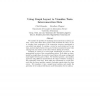Free Online Productivity Tools
i2Speak
i2Symbol
i2OCR
iTex2Img
iWeb2Print
iWeb2Shot
i2Type
iPdf2Split
iPdf2Merge
i2Bopomofo
i2Arabic
i2Style
i2Image
i2PDF
iLatex2Rtf
Sci2ools
GD
1998
Springer
1998
Springer
Using Graph Layout to Visualize Train Interconnection Data
We consider the problem of visualizing interconnections in railway systems. Given time tables from systems with thousands of trains, we are to visualize basic properties of the connection structure represented in a so-called train graph. It contains a vertex for each station met by any train, and one edge between every pair of vertices connected by some train running from one station to the other without halting in between. Positions of vertices in a train graph visualization are given by the geographical location of the corresponding station. If all edges are represented by straight-lines, the result is visual clutter with many overlaps and small angles between pairs of lines. We therefore present a non-uniform approach using different representations for edges of distinct meaning in the exploration of the data. Some edges are represented by curved lines, such that the layout problem consists of placing control points for these curves. We transform it into a graph layout problem and ...
| Added | 05 Aug 2010 |
| Updated | 05 Aug 2010 |
| Type | Conference |
| Year | 1998 |
| Where | GD |
| Authors | Ulrik Brandes, Dorothea Wagner |
Comments (0)

